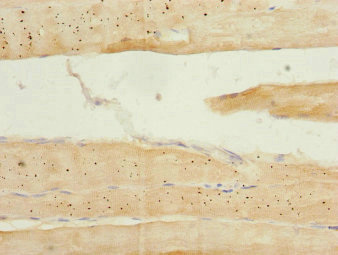NOL3 Antibody
产品详情
-
产品名称:Rabbit anti-Homo sapiens (Human) NOL3 Polyclonal antibody
-
Uniprot No.:O60936
-
基因名:NOL3
-
别名:Apoptosis repressor with CARD antibody; ARC antibody; Muscle enriched cytoplasmic protein antibody; Muscle-enriched cytoplasmic protein antibody; MYC antibody; MYP antibody; Nol3 antibody; NOL3_HUMAN antibody; NOP antibody; Nop30 antibody; Nucleolar protein 3 (apoptosis repressor with CARD domain) antibody; Nucleolar protein 3 antibody; Nucleolar protein of 30 kDa antibody
-
宿主:Rabbit
-
反应种属:Human
-
免疫原:Recombinant Human Nucleolar protein 3 protein (1-208AA)
-
免疫原种属:Homo sapiens (Human)
-
标记方式:Non-conjugated
-
克隆类型:Polyclonal
-
抗体亚型:IgG
-
纯化方式:Antigen Affinity Purified
-
浓度:It differs from different batches. Please contact us to confirm it.
-
保存缓冲液:PBS with 0.02% sodium azide, 50% glycerol, pH7.3.
-
产品提供形式:Liquid
-
应用范围:ELISA, IHC
-
推荐稀释比:
Application Recommended Dilution IHC 1:20-1:200 -
Protocols:
-
储存条件:Upon receipt, store at -20°C or -80°C. Avoid repeated freeze.
-
货期:Basically, we can dispatch the products out in 1-3 working days after receiving your orders. Delivery time maybe differs from different purchasing way or location, please kindly consult your local distributors for specific delivery time.
相关产品
靶点详情
-
功能:May be involved in RNA splicing.; Functions as an apoptosis repressor that blocks multiple modes of cell death. Inhibits extrinsic apoptotic pathways through two different ways. Firstly by interacting with FAS and FADD upon FAS activation blocking death-inducing signaling complex (DISC) assembly. Secondly by interacting with CASP8 in a mitochondria localization- and phosphorylation-dependent manner, limiting the amount of soluble CASP8 available for DISC-mediated activation. Inhibits intrinsic apoptotic pathway in response to a wide range of stresses, through its interaction with ...显示更多
-
基因功能参考文献:
- Results show that in response to DNA damage, p53 total levels increase proportionally to the strength of the damage; however, p53 tetramers are formed at a constant rate under the control of ARC protein. PMID: 25344068
- role of apoptosis repressor with a CARD domain (ARC) in the therapeutic resistance of renal cell carcinoma PMID: 28464919
- a novel genetic primary myelofibrosis-like mouse model and identify a tumor suppressor role for NOL3 in the pathogenesis of myeloid malignancies. PMID: 28232469
- Increased ARC expression is associated with liver metastasis of colorectal cancer. PMID: 26721253
- RUNX3, miR-185 and ARC regulate the sensitivity of gastric cancer cells to chemotherapy. PMID: 24763054
- ARC is regulated via BIRC2/MAP3K14 signalling and its overexpression in AML or MSCs can function as a resistant factor to birinapant-induced leukaemia cell death. PMID: 25079338
- high expression of ARC plays an important role in the pathogenesis of nasopharyngeal carcinoma and leads to X-radiation and cisplatin resistance in nasopharyngeal carcinoma. PMID: 23877130
- ARC is a previously unrecognized inhibitor of apoptosis in beta-cells and that its protective effects are mediated through suppression of the ER stress response pathway. PMID: 22933109
- This study utilized unbiased, genome-wide approaches to identify a NOL3 mutation that likely causes Familial cortical myoclonus. PMID: 22926851
- HIF-1alpha directly bound to hypoxia-responsive element located at -419 to -414 of ARC gene, which is essential for HIF-1-induced expression. PMID: 22475487
- Data show that ARC promotes breast carcinogenesis by driving primary tumor growth, invasion, and metastasis as well as by promoting chemoresistance in invasive cells. PMID: 22037876
- ARC, previously unlinked to pulmonary hypertension, is a critical determinant of vascular remodeling in this syndrome. PMID: 22082675
- Results suggest that ARC expression levels are highly prognostic in AML and that ARC is a potential therapeutic target in AML. PMID: 21041716
- Ras induces ARC in epithelial cancers, and ARC plays a role in the oncogenic actions of Ras PMID: 20392691
- These results suggest that the antiapoptotic effect of apoptotic repressor with caspase recruitment domain is, in part, due to inhibition of voltage-gated potassium channels in cardiomyocytes. PMID: 12734105
- calcium binding mediates regulation of caspase 8 and cell death by ARC PMID: 15509781
- Unexpectedly, ARC was localized almost exclusively to the nuclei of cancer cells, which was unlike the cytoplasmic localization of ARC in non-cancer cells PMID: 15848180
- ARC was present in the cytoplasm and nuclei of epithelial cells in invasive ductal carcinoma PMID: 15861191
- is downregulated in human failing myocardium PMID: 16505176
- nuclear apoptosis repressor with caspase recruitment domain (ARC)is induced in cancer cells and negatively regulates p53 PMID: 18087040
- the high level of ARC protein and the constitutive phosphorylation of ARC in cancer cells may play an important role in the protection of cancer cells against oxidative stress PMID: 18172857
- Transfection of cDNA encoding ARC into Me1007 cells inhibited both caspase-8 activation and apoptosis induced by thapsigargin or tunicamycin. PMID: 18245485
- ARC is a novel marker of human colon cancer and suggest that it may be a general feature of epithelial cancers. PMID: 18469522
- the balance between antiapoptotic ARC and proapoptotic caspase-8 is the only one to be disturbed during carcinogenesis and tumour progression of renal cell carcinomas PMID: 18516683
- ARC undergoes poly-ubiquitination and subsequent proteasome-dependent degradation. Mutation of ARC's lysine residues prevents this and enhances its pro-survival effects. PMID: 17142452
- ARC holds multiple death pathways in check by non-homotypic death-fold interactions. Loss of ARC disinhibits these, leading to accelerated DISC assembly and Bax activation and may be an apoptotic trigger in heart failure and ischemia-reperfusion. PMID: 15383280
- The CARD of ARC binds the Bax C-terminus, preventing Bax activation and activation of the intrinsic mitochondrial pathway PMID: 15383280
- ARC is recruited to the Fas DISC. By interacting with Fas and FADD through CARD-DD and CARD-DED interactions, ARC prevents DISC assembly and procaspase-8 activation. PMID: 15383280
收起更多
-
相关疾病:Myoclonus, familial cortical (FCM)
-
亚细胞定位:[Isoform 1]: Nucleus, nucleolus.; [Isoform 3]: Cytoplasm.; [Isoform 2]: Cytoplasm. Mitochondrion. Sarcoplasmic reticulum. Membrane; Lipid-anchor.
-
组织特异性:Highly expressed in heart and skeletal muscle. Detected at low levels in placenta, liver, kidney and pancreas.
-
数据库链接:
HGNC: 7869
OMIM: 605235
KEGG: hsa:8996
STRING: 9606.ENSP00000268605
UniGene: Hs.513667






















